

Www.dystonia.org.uk/pdf/Drugs_used_for_dystonia ammended.pdf. Torticollis. Oral Medications and Dystonia - Spasmodic Torticollis. Oral Medications and Dystonia John W.

Roberts, MD Virginia Mason Medical Center Seattle, WA Overview This is a review of the oral medications that are used to treat dystonia and oral medications that should be avoided by individuals with dystonia including spasmodic torticollis. Oral Medications to treat dystonia Oral medications may be used together with botulinum toxin injections or they may be used alone. Anticholinergics are drugs that block the transmission of acetylcholine. Muscle Relaxants are a very large group of medications but baclofen (Lioresal®) is the most popular for the treatment of dystonia. Benzodiazepines are another large class of medications and clonazepam is the most popular for the treatment of dystonia. Tetrabenazine is a dopamine depleter. Medications to Avoid. Dystonia Medical Research Foundation. Dystonia is a movement disorder that causes the muscles to contract and spasm involuntarily.
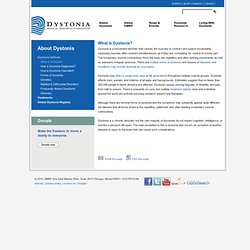
Opposing muscles often contract simultaneously as if they are 'competing' for control of a body part. The involuntary muscle contractions force the body into repetitive and often twisting movements as well as awkward, irregular postures. Focal dystonia. Focal dystonia is a neurological condition that affects a muscle or group of muscles in a specific part of the body causing involuntary muscular contractions and abnormal postures.
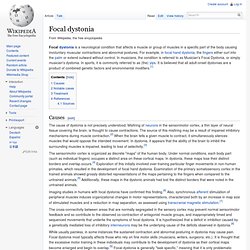
For example, in focal hand dystonia, the fingers either curl into the palm or extend outward without control. In musicians, the condition is referred to as Musician's Focal Dystonia, or simply musician's dystonia. In sports, it is commonly referred to as (the) yips. It is believed that all adult-onset dystonias are a product of combined genetic factors and environmental modifiers.[1] Dystonia Medical Research Foundation. The Dystonia Society - Drug-induced Dystonia (Tardive) Tardive dystonia is the result or an abnormal response to certain medications that have been taken and is characterised by involuntary movements.
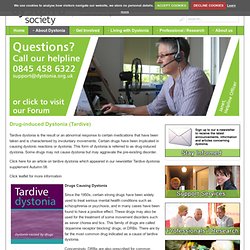
Dystonia. History[edit] The term "dystonia" was first used in 1911, by Hermann Oppenheim.[2] Classification[edit] Types of dystonia[edit] Generalized dystonias[edit] Normal birth history and milestonesAutosomal dominantChildhood onsetStarts in lower limbs and spreads upwardsAlso known as torsion dystonia or idiopathic torsion dystonia (old terminology "dystonia musculorum deformans") Focal dystonias[edit] These are the most common dystonias and tend to be classified as follows:
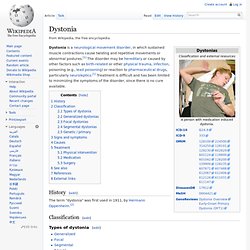
Dystonia Medical Research Foundation. Extrapyramidal symptoms. The extrapyramidal system can be affected in a number of ways, which are revealed in a range of extrapyramidal symptoms (EPS), also known as extrapyramidal side-effects (EPSE), such as akinesia (inability to initiate movement) and akathisia (inability to remain motionless).

Extrapyramidal syndrome (EPS) is due to the blockade of dopamine receptors in the basal ganglia, leading to Parkinson-like symptoms such as slow movement (bradykinesia), stiffness, and tremor. The Simpson-Angus Scale (SAS) and the Barnes Akathisia Rating Scale (BARS) are used to measure extrapyramidal symptoms.[1] Extrapyramidal symptoms are also usually present in patients with neuroleptic malignant syndrome. Causes[edit] The most common antipsychotic associated with EPS is haloperidol used especially for aggression.[2] Other antidopaminergic drugs like the antiemetic metoclopramide or the tricyclic antidepressant amoxapine can also cause extrapyramidal side-effects.
Neuroleptic-induced laryngeal dystonia can mimic anaphylaxis, Australian and New Zealand Journal of Psychiatry. Original Article Neuroleptic-induced laryngeal dystonia can mimic anaphylaxis 1997, Vol. 31, No. 6 , Pages 877-879 Ralf Ilchef.
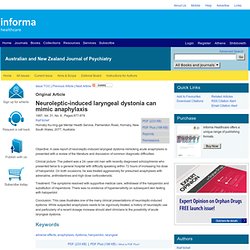
The Journal of Neuropsychiatry and Clinical Neurosciences. To the Editor: Acute laryngeal dystonia is a medical emergency requiring life saving interventions.
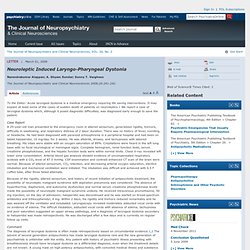
It may explain at least some of the cases of sudden death of patients on neuroleptics.1 We report a case of laryngeal dystonia which, although it posed diagnostic difficulties, was diagnosed early enough to save the patient. A 25-year-old man presented to the emergency room in altered sensorium, generalized rigidity, tremors, difficulty in swallowing, and respiratory distress of 2 days’ duration. Vitamin D Deficiency Linked to Vocal Cord Dysfunction. Hypocapnia. Hypocapnia or hypocapnea also known as hypocarbia, sometimes incorrectly called acapnia, is a state of reduced carbon dioxide in the blood.
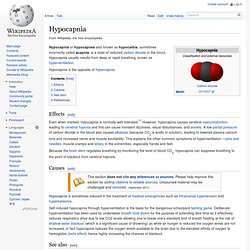
Hypocapnia usually results from deep or rapid breathing, known as hyperventilation. Hypocapnia is the opposite of hypercapnia. My note. Dystonia Medical Research Foundation. Neuroleptic Induced Laryngo-Pharyngeal Dystonia. To the Editor: Acute laryngeal dystonia is a medical emergency requiring life saving interventions.
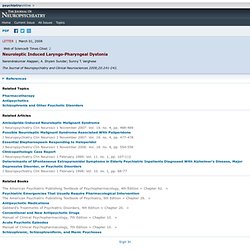
It may explain at least some of the cases of sudden death of patients on neuroleptics.1 We report a case of laryngeal dystonia which, although it posed diagnostic difficulties, was diagnosed early enough to save the patient. A 25-year-old man presented to the emergency room in altered sensorium, generalized rigidity, tremors, difficulty in swallowing, and respiratory distress of 2 days’ duration. There was no history of fever, vomiting, or headache. He had been diagnosed with paranoid schizophrenia in a peripheral hospital and had been on tablet haloperidol, 10 mg/day, for 2 weeks.
He was afebrile, drowsy, and tachypnoeic with labored breathing. Because of the rigidity, altered sensorium, and history of recent initiation of antipsychotic treatment, the possibility of neuroleptic malignant syndrome with aspiration pneumonia was considered. Haloperidol induced laryngeal dystonia. Focal dystonia.